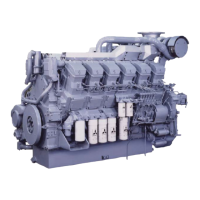1-7
Chapter 1 BASIC SAFETY PRECAUTIONS
Battery
Handle Battery Correctly
Never use flames or allow sparks
near the battery. The battery
releases flammable hydrogen gas
and oxygen gas. Any flames or
sparks in the vicinity could cause an explosion.
Do not use the battery when the battery electrolyte
level is below the "LOWER LEVEL" mark. Continual
use may result in an explosion.
Do not short the battery terminals with a tool or other
metal object.
When removing battery, always remove the plug from
the negative (-) terminal first. When connecting bat-
tery, always connect the plug to the positive (+) termi-
nal first.
Remove all battery cables, then charge the battery in
a well ventilated area.
Make sure the cable clamps are securely installed on
the battery terminals. A loose cable clamp can cause
sparks that may result in an explosion.
Before servicing electrical components or conducting
electric welding, set the battery switch to [Open/OFF]
position or remove the plug from the negative (-) ter-
minal to cut off the electrical current.
Battery electrolyte contains dilute sulfuric acid. Care-
less handling of the battery can lead to loss of sight
and/or skin burns. Also, do not swallow the battery
electrolyte.
Wear protective goggles and rubber gloves when
working with the battery (e.g. when adding water or
charging battery).
If battery electrolyte is spilled onto the skin or clothing,
immediately wash it away with lots of water. Use soap
to thoroughly clean.
The battery electrolyte can cause sight loss if splash-
ing into your eyes. If it gets into your eyes, immediate-
ly flush it away with plenty of clean water, and seek
immediate medical attention.
If you accidentally swallow battery electrolyte, gargle
with plenty of water and then drink lots of water, and
seek immediate medical attention.
If the battery does not fully recover after 24 hours
charging or more, do not use the battery.

